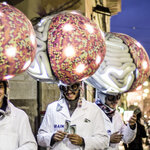Neuroscience

How did the world sound to our ancient human relatives two million years ago?
While we obviously don’t have any sound recordings or written records from anywhere near that long ago, we do have one clue: the fossilized bones from inside their ears. The internal anatomy of the ear influences its hearing abilities.
Using CT scans and careful virtual reconstructions, my international colleagues and I think we’ve demonstrated how our very ancient ancestors heard the world. And this isn’t just an academic enterprise; hearing abilities are closely tied with verbal communication. By figuring out…

Researchhas linked the abnormal behavior of two genes (BDNF and DTNBP1) to the underlying cause of schizophrenia. These findings have provided a new target for schizophrenia treatment.
Schizophrenia is a devastating mental disorder that affects nearly 1% of the total human population. The dominant cause of the disorder lies in impaired brain development that eventually leads to imbalanced signals within the brain. This imbalance within the brain is thought to cause hallucinations and paranoia in people with schizophrenia.
"We wanted to understand the mechanism by which the brain circuit…

Neural stem cells generate new neurons throughout life in the mammalian brain. However, with advancing age the potential for regeneration in the brain dramatically declines. Scientists from the University of Zurich now identified a novel mechanism of how neural stem cells stay relatively free of aging-induced damage.
A diffusion barrier regulates the sorting of damaged proteins during cell division.
Yeast are good for making wine, bread, and brewing beer. But they are also a good model for neural stem cells in the mammalian brain. It was known that with every division cellular aging factors…

Researchers are saying a new analysis of data on the genetics of autism spectrum disorder disputes a commonly held belief that autism results from the chance combinations of commonly occurring gene mutations, which are otherwise harmless.
They find, instead, further evidence to suggest that devastating "ultra-rare" mutations of genes that they classify as "vulnerable" play a causal role in roughly half of all autism spectrum disorder cases. The vulnerable genes to which they refer harbor what they call an LGD, or likely gene-disruption. These LGD mutations can occur "spontaneously"…

Scientists at Karolinska Institutet and Karolinska University Hospital in Sweden have discovered a new explanation for severe early infant epilepsy. Mutations in the gene encoding the protein KCC2 can cause the disease, hereby confirming an earlier theory. The findings are being published in the journal Nature Communications.
Through large-scale genetic analyses of a family with two affected children at SciLifeLab in Stockholm, mutations were identified in the gene encoding the transport protein KCC2. In a collaboration with scientists at the University College London, another family with…

Girls with autism display less repetitive and restricted behavior than boys do, according to a study by researchers at the Stanford University School of Medicine.
The study also found that brain differences between boys and girls with autism help explain this discrepancy.
The study, which will be published online Sept. 3 in Molecular Autism, gives the best evidence to date that boys and girls exhibit the developmental disorder differently.
"We wanted to know which specific clinical manifestations of autism show significant gender differences, and whether patterns in the brain's gray matter…

Scientists have pinpointed a population of neurons in the brain that influences whether one drink leads to two, which could ultimately lead to a cure for alcoholism and other addictions.
A new study finds that alcohol consumption alters the structure and function of neurons in the dorsomedial striatum, a part of the brain known to be important in goal-driven behaviors. The findings could be an important step toward creation of a drug to combat alcoholism.
"Alcoholism is a very common disease," said Jun Wang, M.D., Ph.D., the lead author on the paper and an assistant professor in the…

Male teens who experiment with cannabis before age 16, and have a high genetic risk for schizophrenia, show a different brain development trajectory than low risk peers who use cannabis.
The discovery, made from a combined analysis of over 1,500 youth, contributes to a growing body of evidence implicating cannabis use in adolescence and schizophrenia later in life.
Adolescence is a period of vulnerability with regard to the emergence of psychotic disorders, especially in boys. Environmental influences on the continuing maturation of neural circuits during adolescence are of great…

Repetitive transcranial magnetic stimulation can help alleviate symptoms of autism, such as anxiety. AGUILA_JONATHAN/Flickr, CC BY-NC-ND
By Peter Enticott, Deakin University
Around 1 in 68 children has an autism spectrum disorder (ASD), according to the US Centers for Disease Control – an extraordinarily high number.
Although the prevalence rise is probably due mainly to changes in how we diagnose and classify ASD – autism was once considered a rare condition affecting only one among thousands – it has become a huge public-health challenge.
One way to help ASD patients may be with…

Want more working memory? Then you need to expand your brain. Credit: Flickr/Elena Gatti, CC BY
By Joel Pearson
Before we had mobile phones, people had to use their own memory to store long phone numbers (or write them down). But getting those numbers into long-term memory could be a real pain.
People had to write the number down, say it over and over again to themselves. With each verbal iteration, something annoying would happen, and the number would often fade out of memory. To get the number into long-term memory you had to keep repeating the number fast enough to beat the fade-away.
This…